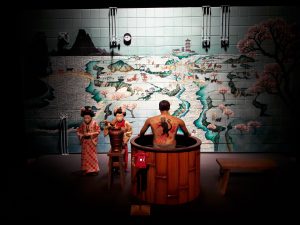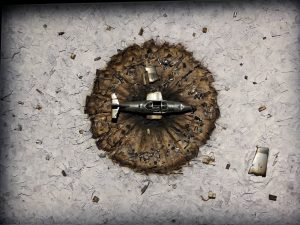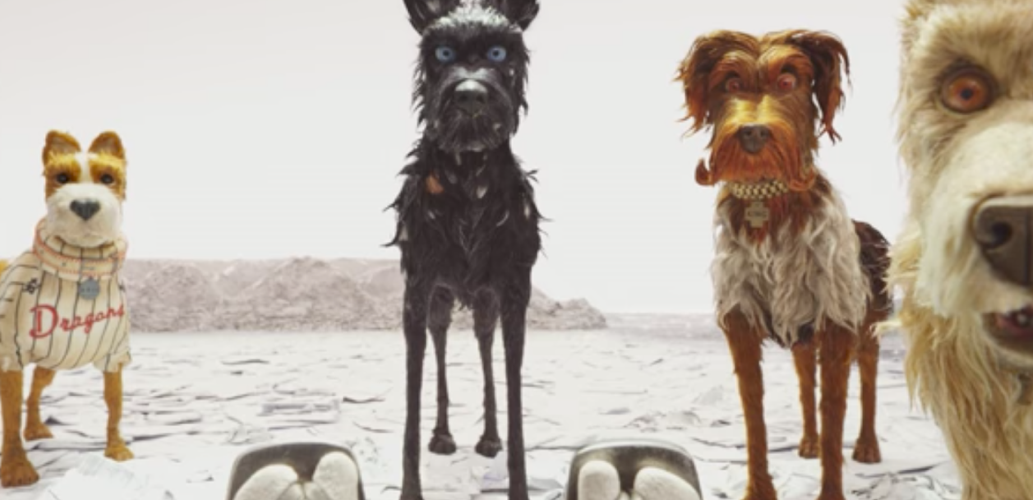Sit. Stay. Roll over. Applaud.
After four years since his last film, Wes Anderson returns to the world stop-motion for Isle Of Dogs. Set in a near-future Japan where canine flu has resulted in the banishment of all dogs to a trash island, five dogs help a young boy find his best friend Spots.
The cast, as you might expect from a Wes Anderson film by now, features the voices of long time collaborators like Jeff Goldblum, Bill Murray and Bob Balaban, but also features new big-hitters like Bryan Cranston, Greta Gerwig and Liev Schreiber. In a way, Anderson’s preferred cast pool gets larger with each film, adding big names each time.

For The Grand Budapest Hotel, Anderson got a lot of plaudits, but personally it doesn’t rank highly for me in his oeuvre – top of the pile would be Rushmore, by the way – though it is still a top notch film. This film, in my opinion, deserves all the accolades and praise it gets (I went to see it twice in two days). Not only is it a great little story with all of Anderson’s quirks, but the amount of artistry and dedication which has been shown to the stop motion models, sets and design is staggering.
Let’s look at the actual meat of the story first. It’s not quite the “bad dad” scenario this time, more a maniacal uncle, Mayor Kobayashi, whose decree sets the story in motion. Much as with Anderson’s first stop-motion feature Fantastic Mr. Fox, this is more a story of animals versus man, with the dogs on trash island needing to scrap for their lives.
With the story centering around Atari’s quest for his dog, and with this being an Anderson film, you can expect to have your heartstrings pulled at the strangest moments. Lines like “I can hear your Master Atari” and “Was I the runt of the litter?” seem so innocuous but lend great weight to your attachment for these characters.
The action is never too much and much the gravity of the situation is never rendered depressing though, quite the opposite. The understated humour, another calling card for Anderson, is dotted throughout, keeping that air of fun about proceedings. The film glides effortlessly along, captivating but softly charming in a way you might associate to a Hayao Miyazaki film.
You could also read political statements from the film if you choose to go looking, as an under appreciated section of society is cut off after a campaign of fear is waged. This might be reaching too far, but it is a fairly easily one to recognise – especially when scientific evidence for a cure to end canine flu is suppressed by the mayor.
‘From the sushi creation, to the silhouettes of the dogs inside a multi-coloured bottle cave, the sets and the characters are artfully rendered and shot’
The cultural aspects of this film have been at the centre of discussion, with some claiming that Anderson is fetishising Japan for his own gain. And to some extent, yes, we see Japanese temples, taiko drumming and sumo wrestling, but it’s all lovingly rendered in great detail. Having brought in Japanese designers to work with – as well as famous voices for the cast – he has made a lot of effort to get all aspects of the film right, from the language in the script to the Japanese writing on screen. Japanese characters always speak their native language and are never subtitled, but the film finds fun ways of interpreting them for key runs of dialogue (including the use of Frances McDormand).

Want another argument against this criticism? It’s a futuristic rendering, so wind your necks in; the leaps come from imagination and are infused with traditional iconography for what is a compelling and fresh feeling film. Do we ever get lippy when we see the UK established with people sipping tea on red buses as they go cruising past Big Ben? I certainly don’t, and people seem very quick to be offended on behalf of other cultures before finding out how those people themselves feel.
You can also see a great deal of homage being paid by Anderson to classic Japanese filmmakers such as Akira Kurosawa, including a nod to his Drunken Angel in the soundtrack. This in itself should spell out one of Anderson’s key intentions, bringing his stylistic shooting to a land which has given the world of cinema so much. For me, it shouldn’t be an issue to set a film in another country if you pay it enough attention and do your research.
On now to how brilliantly this is shot, and you could pick out numerous scenes in this film which highlight why Anderson is one of the best directors out there. From the close up, detailed sushi creation, to the silhouettes of the dogs inside a multi-coloured bottle cave, the sets and the characters are artfully rendered and shot. You wouldn’t think a trash island could be this interesting, but it actually plays host to some of the most interesting settings and backdrops.

The soundtrack from Alexandre Desplat, who also put his musical signature to The Grand Budapest Hotel, plays has a hugely understated hand to play in the film, with traditional drumming, choral effects and just a little of Anderson’s classic off-kilter pep. Desplat mixes these old sounds of Japan with a modern soundtrack style to bring something entirely new together – just like the city of Megasaki. Oddly, there is only one regular song plucked from Anderson’s favoured 60s sounds, and it seems like these types of songs are appearing in his films less and less, which is a shame because he has a knack for compiling excellent tracks from across the decades – some by bands you know, others who you might not – and giving his films another layer understated cool.
Make no mistake, this isn’t going to keep a braying pack of eight-year-olds entertained; it’s a kids film for adults. In the trailers before this film, there is a horrendous looking film with talking dogs called Show Dogs – the only reason I mention this is to point out the kind of trash that is fed up for kids usually. If you’re going to see one film about dogs this year with your kids, make it Isle Of Dogs.
